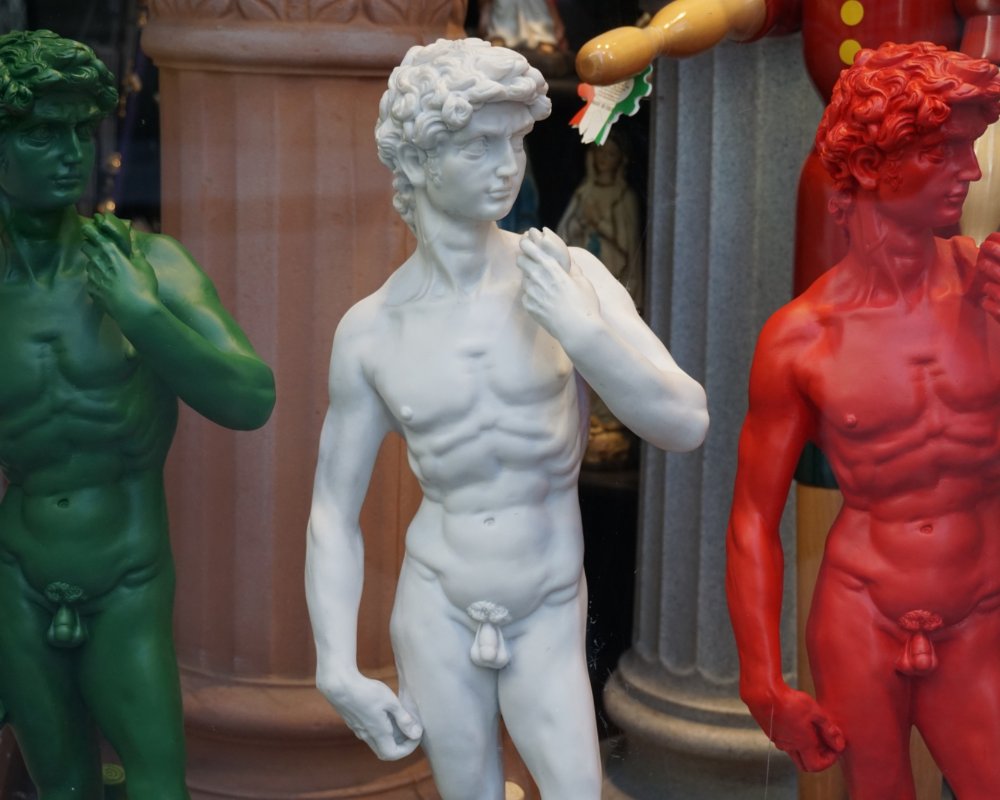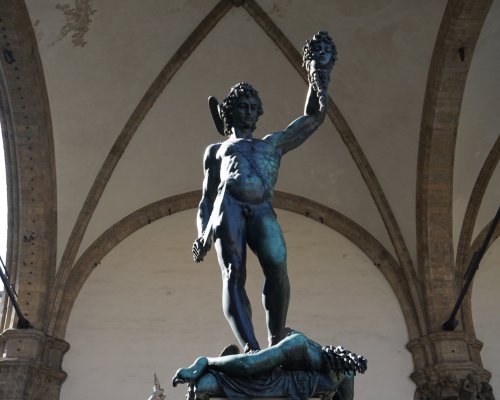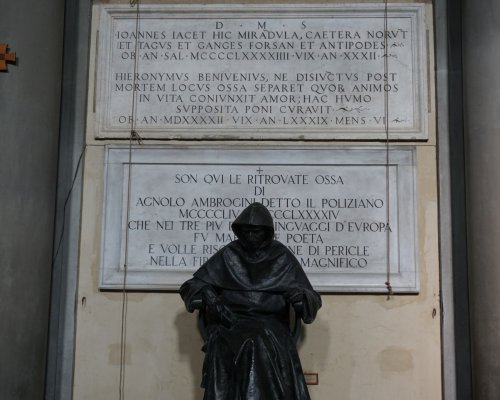A journey through love stories and art work in the city of the lily
Start your day early, you have a mission: find the key places in gay-friendly Florence. Retrace the steps of the LGBT movement in Florence, and in Tuscany, from the Renaissance to the first Pride.
This itinerary will cast a new light on the best-known places but will also reveal hidden corners that deserve to be discovered through inclusivity.
The first part of your journey starts with a visit to the Basilica of Santissima Annunziata. The luxurious exterior still hides traces of frescoes which adorn the façade. But once you’re inside, the rigidity moves aside to reveal the Baroque splendour. Marble, stuccos and paintings astound you and fill your eyes with beauty. Going to the mortuary chapel of the basilica, the most striking tomb is that of Benvenuto Cellini.
The sculpture of Perseus with Medusa’s head that you can admire in the Loggia dei Lanzi rests here and his story is closely linked with homosexuality in Renaissance Florence. It’s no secret that during the Renaissance Florence was a free place where homosexuals could exhibit their orientation with no worries. In the language of the time, the German word for ‘homosexual’ was Florenzen. The Tuscan city seemed to be a real gay-friendly paradise, or at least it was until the beginning of the 15th century, when a series of social disgraces lead to the creation of the Ufficiali di Notte (Night Officers), a sort of moral police. There were over 10,000 charges, arrests and cases brought before the judges. Among these was Benvenuto Cellini, accused of sodomy three times between 1523 and 1556. The crime: having loved other men.
The first part of your journey starts with a visit to the Basilica of Santissima Annunziata. The luxurious exterior still hides traces of frescoes which adorn the façade. But once you’re inside, the rigidity moves aside to reveal the Baroque splendour. Marble, stuccos and paintings astound you and fill your eyes with beauty. Going to the mortuary chapel of the basilica, the most striking tomb is that of Benvenuto Cellini.
The sculpture of Perseus with Medusa’s head that you can admire in the Loggia dei Lanzi rests here and his story is closely linked with homosexuality in Renaissance Florence. It’s no secret that during the Renaissance Florence was a free place where homosexuals could exhibit their orientation with no worries. In the language of the time, the German word for ‘homosexual’ was Florenzen. The Tuscan city seemed to be a real gay-friendly paradise, or at least it was until the beginning of the 15th century, when a series of social disgraces lead to the creation of the Ufficiali di Notte (Night Officers), a sort of moral police. There were over 10,000 charges, arrests and cases brought before the judges. Among these was Benvenuto Cellini, accused of sodomy three times between 1523 and 1556. The crime: having loved other men.
The tour continues, moving a few metres to the Church of San Marco. The last church of the day. This time however, you will be exploring a love story which lasts for over 500 years. Don’t be misled by the façade again. The interior is a splendid triumph of gold in clear contrast with the strict lines of the neoclassical exterior. Admire the works of art on display in the basilica and then you will find the commemorative plaque about love. It is the story of Pico della Mirandola and Girolamo Benivieni. Their love story is sealed in the Latin inscription:
Here lies Giovanni Mirandola, also known as il Tago, il Gange and maybe even Antipodi.
He died in 1494, lived for 32 years.
Girolamo Benivieni arranged to be buried in the earth below, so that after death the separation of places does not separate the bones of those whose spirits in love joined in Love.
He died in 1542, lived for 89 years and 6 months
The two were lovers, Pico died young while Girolamo died 50 years later. But loyal to his love he kept his promise and was buried with him, so that they could be together forever. Leave a flower for the two lovers and go towards the Uffizi.
The tour continues, moving a few metres to the Church of San Marco. The last church of the day. This time however, you will be exploring a love story which lasts for over 500 years. Don’t be misled by the façade again. The interior is a splendid triumph of gold in clear contrast with the strict lines of the neoclassical exterior. Admire the works of art on display in the basilica and then you will find the commemorative plaque about love. It is the story of Pico della Mirandola and Girolamo Benivieni. Their love story is sealed in the Latin inscription:
Here lies Giovanni Mirandola, also known as il Tago, il Gange and maybe even Antipodi.
He died in 1494, lived for 32 years.
Girolamo Benivieni arranged to be buried in the earth below, so that after death the separation of places does not separate the bones of those whose spirits in love joined in Love.
He died in 1542, lived for 89 years and 6 months
The two were lovers, Pico died young while Girolamo died 50 years later. But loyal to his love he kept his promise and was buried with him, so that they could be together forever. Leave a flower for the two lovers and go towards the Uffizi.
The Uffizi Galleries is something you have to experience at least once in your life, and once you enter you will most definitely be stunned by the beauty of the artworks. Although it is obligatory to go and see The Birth of Venus and Primavera by Botticelli, we recommend heading to room number 38. The statue of the sleeping hermaphrodite is a Roman copy from the Imperial Age of the Hellenistic original from the 2nd century BCE. The son of Hermes and Aphrodite lies, trapped in a 1000-year sleep. Just outside the room of Ermafrodito and other statue catches your eye. Pan and Daphnis tells the story of the son of the nymph Daphnis and loved by the god Hermes. The scene of the statue is one that depicts Pan, a god with strong sexual connotations, trying to teach the art of music to his disciple Dafni. There is a tangible erotic tension in the statue, also a Roman copy of a 2nd century original.
The Uffizi Galleries is something you have to experience at least once in your life, and once you enter you will most definitely be stunned by the beauty of the artworks. Although it is obligatory to go and see The Birth of Venus and Primavera by Botticelli, we recommend heading to room number 38. The statue of the sleeping hermaphrodite is a Roman copy from the Imperial Age of the Hellenistic original from the 2nd century BCE. The son of Hermes and Aphrodite lies, trapped in a 1000-year sleep. Just outside the room of Ermafrodito and other statue catches your eye. Pan and Daphnis tells the story of the son of the nymph Daphnis and loved by the god Hermes. The scene of the statue is one that depicts Pan, a god with strong sexual connotations, trying to teach the art of music to his disciple Dafni. There is a tangible erotic tension in the statue, also a Roman copy of a 2nd century original.
Leaving the Uffizi Galleries and turning towards Palazzo Pitti, or the Pitti Palace. Here you can spend hours visiting the palace and walking through the Boboli Gardens. Walking through the rooms of the palace you will soon learn just how many tales these walls have to tell. You will hear about the epic love story of Gian Gastone de Medici, the last of the Medici dynasty. Who knows which of Gian Gastone’s rooms were visited by his lovers, men from every social sphere. Although he is known in history as a lazy ruler, the last Medici heir had strong ideas. He was the one who abolished the laws against prostitutes and Jews, to dedicate solemn funerals to Galileo Galilei and control the powers of the church. All acts which laid the foundations for his successor, Leopold I of Tuscany. It’s thanks to the Grand Duke that the conquest of civil rights leaped forward: he abolished the death penalty and in 1853 he decriminalised homosexuality.
Leaving the Uffizi Galleries and turning towards Palazzo Pitti, or the Pitti Palace. Here you can spend hours visiting the palace and walking through the Boboli Gardens. Walking through the rooms of the palace you will soon learn just how many tales these walls have to tell. You will hear about the epic love story of Gian Gastone de Medici, the last of the Medici dynasty. Who knows which of Gian Gastone’s rooms were visited by his lovers, men from every social sphere. Although he is known in history as a lazy ruler, the last Medici heir had strong ideas. He was the one who abolished the laws against prostitutes and Jews, to dedicate solemn funerals to Galileo Galilei and control the powers of the church. All acts which laid the foundations for his successor, Leopold I of Tuscany. It’s thanks to the Grand Duke that the conquest of civil rights leaped forward: he abolished the death penalty and in 1853 he decriminalised homosexuality.
Finish your tour by going towards Santa Croce, passing through Piazza della Signoria. Civil Ceremonies are celebrated in the rooms of the Palazzo Vecchio and it is the final stop in Gay Pride. On this journey you will see many works of street art which cover the walls of the centre of Florence. Once you get to the little gay street, stop in one of the bars in Borgo Santa Croce, our tour ends with a spritz and meeting new people.
At the end of this day in central Florence, you can see how the history of Florence has shaped the Tuscany of today, one of the most gay-friendly regions in Italy. Just think of the beaches and bars in Versilia and the story of the first Italian pride, which took place in Tuscany, in Pisa.
Finish your tour by going towards Santa Croce, passing through Piazza della Signoria. Civil Ceremonies are celebrated in the rooms of the Palazzo Vecchio and it is the final stop in Gay Pride. On this journey you will see many works of street art which cover the walls of the centre of Florence. Once you get to the little gay street, stop in one of the bars in Borgo Santa Croce, our tour ends with a spritz and meeting new people.
At the end of this day in central Florence, you can see how the history of Florence has shaped the Tuscany of today, one of the most gay-friendly regions in Italy. Just think of the beaches and bars in Versilia and the story of the first Italian pride, which took place in Tuscany, in Pisa.


